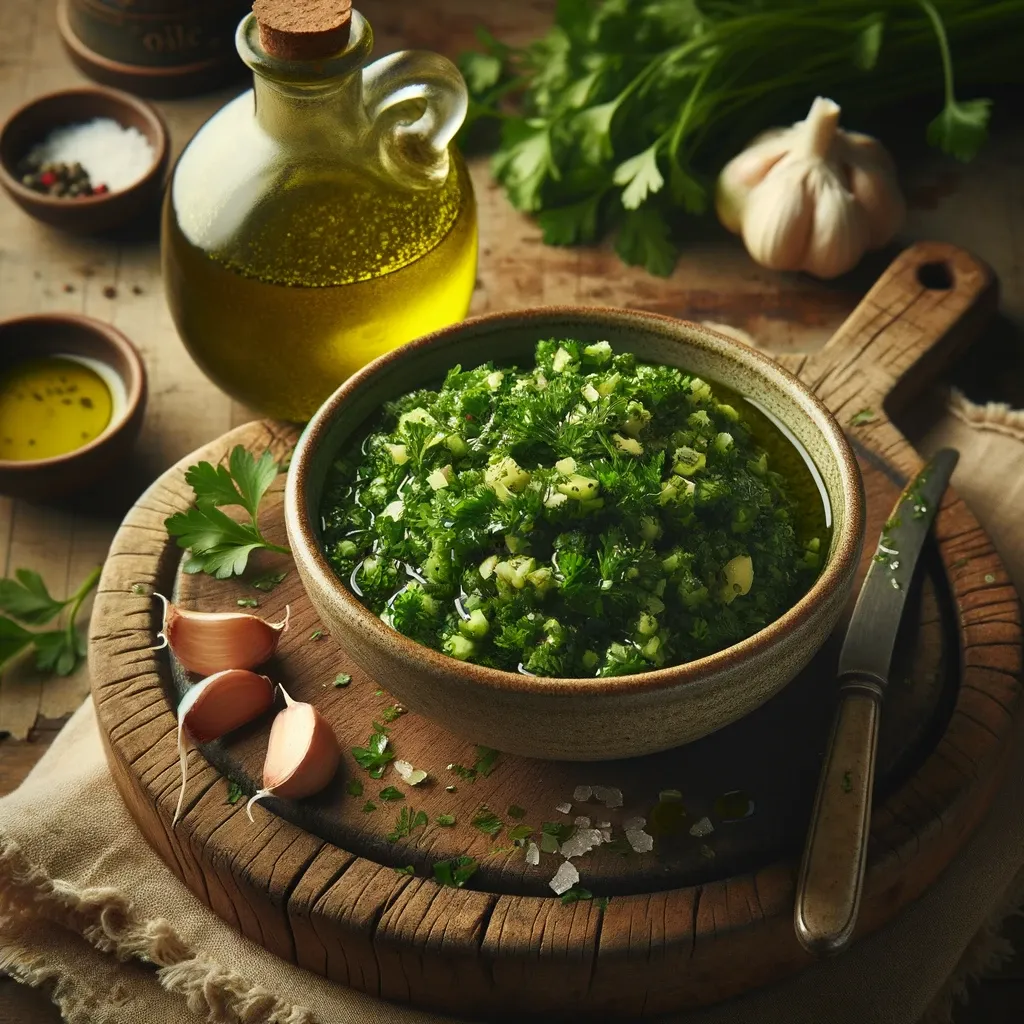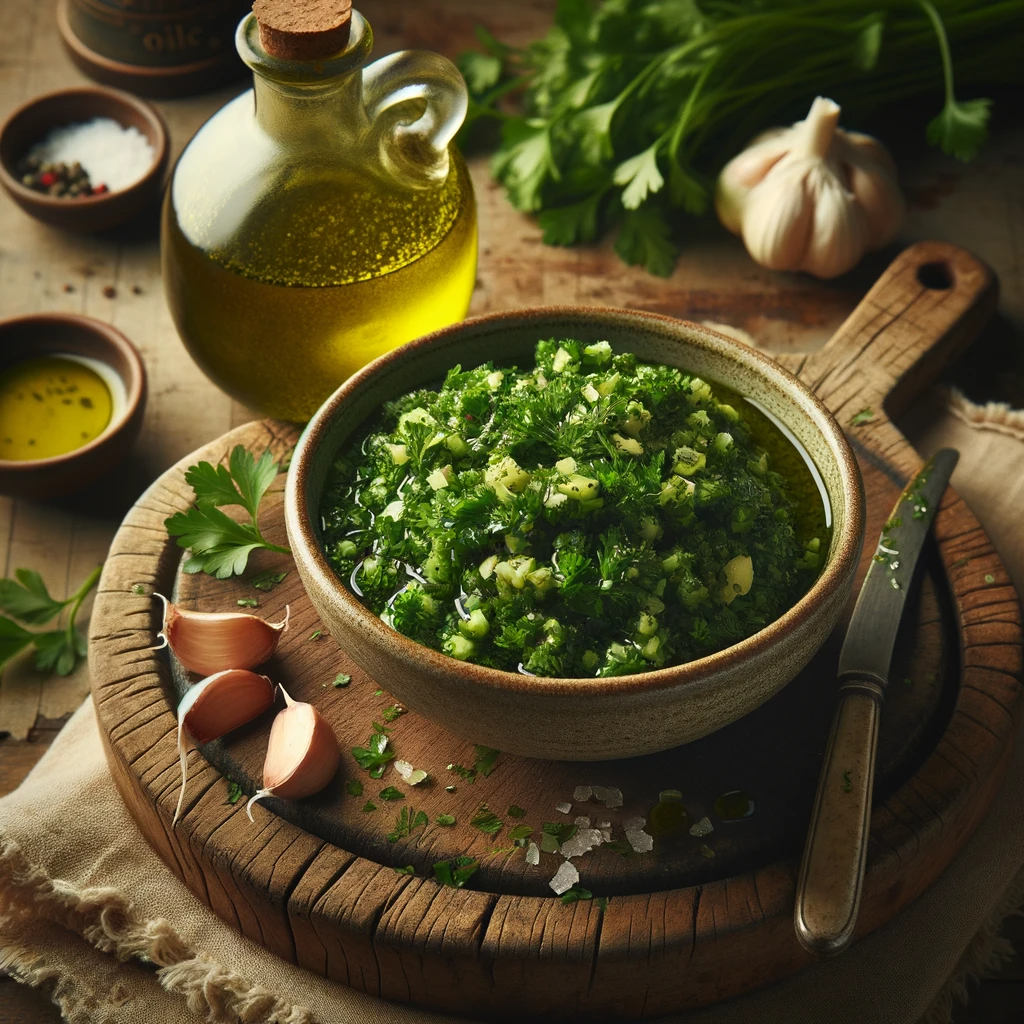Persillade
We’re excited to share a gem from the heart of French cuisine: persillade, an aromatic celebration of freshness and aroma that can enliven any dish it touches.

The core of persillade
Garlic: The backbone of persillade. Each clove packs a punch of sharp flavor, blending beautifully with other ingredients. It’s not just about taste; garlic brings health benefits, too, like antibacterial and antioxidant properties. We love how even a tiny amount can wake up the palate.
Parsley: This herb adds a fresh, vibrant touch. We prefer flat-leaf parsley for its robust flavor, contrasting nicely with the potent garlic. Not just a garnish, parsley is rich in vitamins and contributes to the overall nutritional value of the dish.
Olive oil: This is the silk that binds everything together. We use extra virgin olive oil for its fruity notes and smooth texture, and it not only enriches the persillade but also brings heart-healthy fats to our table.
Vinegar: Though not a traditional ingredient, a splash of vinegar can add a tangy brightness. Red or white wine vinegar balances the oil’s richness and garlic’s potency, adding a subtle acidity.
Variations of Persillade
Persillade is a remarkably adaptable garnish, offering a wide range of variations - the classic persillade is a simple yet flavorful combination of chopped parsley, minced garlic, and olive oil, but why stop there? Here are some of our twists that we think you’ll enjoy;
- Citrusy twist: Adding grated lemon or orange zest to the classic mix, infusing a refreshing brightness.
- Herb infused: If you’re keen on experimenting with herbs, a blend of parsley, tarragon, and chervil, combined with garlic and olive oil, creates an aromatic herb medley.
- Spicy: Those who prefer a bit of heat can incorporate red pepper flakes into the traditional recipe for a spicy kick.
- Anchovy: finely chopped anchovies can be added to the standard persillade, offering a savory depth. You can also go for a Mediterranean blend by mixing parsley and basil with garlic, capers, and olive oil, creating a variant that pairs well with various dishes.
- Balsamic vinegar: If you want to add a tangy note, try a splash of balsamic vinegar with the usual parsley and garlic.
- Cheese lovers: A cheesy delight version, where grated Parmesan is combined with the classic ingredients.
- Nutty twist: Add chopped walnuts, almonds, or pine nuts to the mix. This not only adds a unique flavor but also a delightful crunch.
Versatility
This aromatic condiment pairs wonderfully with a variety of dishes; here are some of the ways that persillade can elevate the flavor in your meals;
- Grilled and roasted meats: Persillade perfectly accompanies grilled steak, roast chicken, or lamb chops. Its fresh and garlicky taste complements the rich flavors of the meat.
- Seafood: It works beautifully when sprinkled over grilled or baked fish, shrimp, or scallops. The freshness of parsley and the kick of garlic enhance the delicate flavors of seafood.
- Vegetables: Toss roasted or steamed vegetables like potatoes, green beans, carrots, or asparagus with persillade for an instant flavor boost. It adds a lovely herby and garlicky note to the vegetables.
- Pasta and Risotto: Stirring persillade into pasta dishes or risotto at the end of cooking adds a fresh, herbaceous element. It pairs exceptionally well with lighter sauces or olive oil-based pasta dishes.
- Garlic bread: Spread persillade on crusty bread or baguettes, either as is or mixed into butter, for delicious garlic bread. It can also elevate sandwiches and bruschetta with its zesty flavor - check out our Italian twist breadstick recipe for inspiration!

- Eggs: Sprinkle persillade over scrambled eggs, omelets, or frittatas for a fresh, herby twist.
- Soups and stews: Adding persillade to soups and stews, especially towards the end of cooking, can brighten up the dish and add fresh flavor.
- Grains: Mix it into cooked grains like quinoa, rice, or couscous for an easy and flavorful side dish.
- Salads: Use persillade as a component in salad dressings or sprinkle it over salads for added flavor and texture.
- Potato dishes: It’s particularly delicious with French fries, potato wedges, or mashed potatoes, adding a garlicky, herby touch.
Our tips for the perfect persillade
- When chopping garlic and parsley, aim for a coarse texture to retain their natural flavors.
- When adding vinegar, drizzle it in gradually and taste as you go - it’s all about finding that perfect balance.
- Experiment with different herbs and spices. Remember, the best part of cooking is making a dish your own.
How should I store persillade?
Store it in an airtight container in the refrigerator for up to a week and let it come to room temperature before use to best enjoy its full flavor profile.
Can I use dried parsley for persillade?
Fresh parsley is preferable for its vibrant color and flavor, but in a pinch, dried parsley can work. Just remember to use it sparingly, as the dried version is more concentrated.
Is there a difference between persillade and gremolata?
Yes, while both are parsley-based garnishes, gremolata typically includes lemon zest and sometimes anchovy, in addition to garlic, and is associated with Italian cuisine.
What dishes pair well with persillade?
Persillade is incredibly versatile. It's fantastic sprinkled over grilled meats, roasted vegetables, baked fish, or stirred into stews and soups. It's also a great finishing touch for potatoes or mixed into breadcrumbs for a crispy topping.
How can I adjust persillade for a milder garlic flavor?
If raw garlic is too overpowering, you can blanch the garlic cloves in boiling water for 1 minute before chopping. It will provide a sweeter, more mellow garlic flavor that's just as delicious.
Can persillade be made in advance?
Yes, it can be prepared ahead of time, though it is best used fresh to maintain its vibrant color and zesty flavor.
Persillade
Persillade is a classic French condiment made with fresh parsley and garlic, often enriched with olive oil and a touch of vinegar. This simple yet flavorful mixture is a staple in French cuisine, known for its ability to enhance a wide range of dishes.
Cuisine
French
Serves
12
Prep
10 mins
Cook
0 mins
Total
10 mins
Calories
58 kcal

Ingredients
2 cups fresh parsley
3 cloves garlic
6 tablespoons extra-virgin olive oil
4 tablespoons red wine vinegar
1/2 teaspoon salt
1/4 teaspoon freshly ground black pepper
Instructions
Finely chop the parsley leaves and the garlic cloves. For a finer texture, you can use a food processor, but do not over-process to avoid turning it into a paste.
In a mixing bowl, combine the chopped parsley and garlic. Add in the salt, pepper and optional herbs if using, and mix until well combined.
Drizzle in the olive oil and red wine vinegar while stirring the mixture to evenly coat the parsley and garlic, ensuring the mixture is not too oily.
Taste the persillade and adjust the seasoning with more salt, pepper, or lemon juice to your preference.
Use immediately, or store in an airtight container in the refrigerator for up to a week.
Notes
If you prefer a milder garlic flavor, you can blanch the garlic cloves in boiling water for 1 minute before chopping.
Nutrition
- Calories 58 kcal |
- Carbohydrate Content 1 g |
- Cholesterol Content 0 mg |
- Fat Content 6 g |
- Fiber Content 0.25 g |
- Protein Content 0.3 g |
- Serving Size 1 portion |
- Sodium Content 10 mg |
- Sugar Content 0.05 g |
About the author
Emma Donin is the culinary maestro behind this blog that serves as a melting pot of global cuisines and gastronomic adventures. Her culinary journey began in her grandmother's kitchen, where she learned the fundamentals of cooking and the importance of using fresh, quality ingredients.
